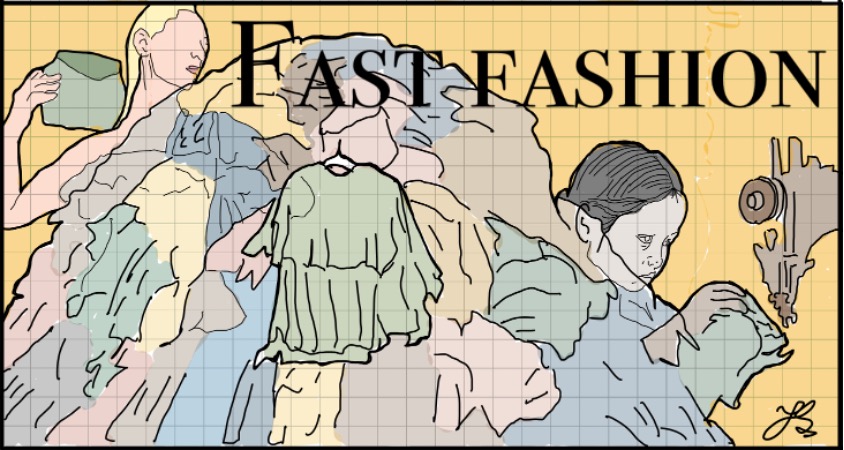Why do low clothing prices generate huge social and climate issues?
Students reflect on fast fashion and its impact.

“When we started implementing our project, we wanted to show, in an accessible way, the dangers of excessive consumerism and simple ways to reverse it,” Gabriela Tomaszewska says.
Tomaszewska is one of many students who have decided to take matters into their own hands and stand against fast fashion, showing the exceptional sensitivity of young people to issues of climate change and human rights.
Contemporary fashion is dynamic and easily accessible. New styles and accessories go viral on social media, making young consumers around the world follow trends to look fashionable and attractive. Behind the fast pace of production and consumption of the fashion industry, there are big problems like fast fashion. It is a business model that generates mass production of fashionable clothes, inspired by the latest trends, quickly and at low prices. Young creators of the ecological social project, which works to educate students on the harms of fast fashion, agreed to share their experiences related to the project, the difficulties they overcame and the knowledge they acquired during the creation process.
“At that time, I was shopping more and more often in second-hand stores, and I became interested in the impact that fast fashion had on our lives. At the same time, I noticed that still few people, including my peers, were aware of this problem,” Tomaszewska said. Tomaszewska is a student and participant of “sECO-hand,” a social and ecological organization founded by four students in 2021 with the goal of encouraging people to buy second-hand clothes and promoting conscious fashion.
“Providing facts is the most important at a time when, despite some development of awareness on this topic, global fast fashion platforms for pennies are flourishing. We decided that the project, and its form, was the right path to counteract this,” Tomaszewska said.
After coming up with the idea to form a group and gathering the team, all that remained was to get started. The group’s activity consisted of posting on social media regarding the promotion of conscious fashion, encouraging people to buy in secondhand stores and educating about the harmful effects of fast fashion.
“We created posts based on articles about fast fashion. Many of them were found on ecology forums and in regular newspapers,” Hanna Cebrat, another participant in the project, said.
The texts were enriched with photo sessions showing outfits made entirely of clothes from the thrift stores. The idea was to show that people can still look fashionable in secondhand clothes. Outfits were thematic and diverse to prove that regardless of style, everyone can find something for themselves.
Wearing used clothes used to be considered a cause for shame and a taboo. How has adolescents’ thinking changed over the last few years?
“Over the last few years, the attitude of young people toward secondhand shopping has improved significantly. You could even say that wearing secondhand clothes has become fashionable. Therefore, our project was positively received and served as a source of knowledge for people who want to change their lifestyle to a more sustainable one,” Cebrat said.
Despite the positive feedback, “sECO-hand” has experienced some tough moments and obstacles.
“Difficulties often appeared when it was necessary to combine writing substantive posts, organizing sessions, conducting workshops and publicizing activities in the media with school and everyday life,” Greta Gogolewska, another member of the ecological passion project, said.
Gogolewska opened up about the difficulties the group encountered while implementing the project. “It wasn’t always easy to get interviews and media mentions, sometimes they contacted us, but sometimes we wrote and got called with requests to publicize the topic, and we were often told that the topic was not interesting to people because the coronavirus pandemic was going on at that time and no one wanted to write about fast fashion.”
According to statistics posted by Earth.Org, “the fashion industry is responsible for 20% of global wastewater.” What is more, Earth.Org writes that “about 2,700 litres of water are needed to make just one t-shirt, which would be enough for one person to drink for 900 days.”
“The two greatest threats are progressive labor exploitation and environmental pollution. Huge fashion concerns often have no mercy for their employees in second and third-world countries. They work for starvation wages and, unfortunately, usually in scandalous conditions,” said Tomaszewska, when asked about the dangers of fast fashion.
What makes people turn to fast fashion? Is it the cheap price or the speed of new collections appearing?
“I think some people do it unconsciously. Nevertheless, nowadays we receive so much news from around the world that most people do not realize what a huge problem the fast fashion industry is,” Gogolewka told the News.
So, what can consumers do to buy consciously and not support fast fashion brands?
“There are many solutions,” Godlewka said. “We can look for clothes first in secondhand stores before we go to the shopping mall. We can alter the clothes we already have or exchange them with other people. Being aware of your needs and what you already have in your wardrobe is also very helpful. This way, it’s easier to avoid impulse purchases and buy less.”
Fashion affects all areas of our lives. It is a tool that allows us to express ourselves, emphasize our personality and affiliate with particular cultures or social movements. Our purchasing decisions also affect the lives and safety of those who sew our clothes, as well as climate change and the environment around us.






